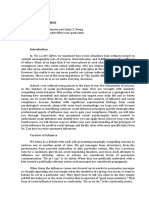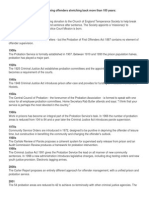Verbal Aikido: How To Respond To Unreasonable Challenges: 330 Mindfulness Worksheets
Verbal Aikido: How To Respond To Unreasonable Challenges: 330 Mindfulness Worksheets
Uploaded by
Miguel Barata GonçalvesCopyright:
Available Formats
Verbal Aikido: How To Respond To Unreasonable Challenges: 330 Mindfulness Worksheets
Verbal Aikido: How To Respond To Unreasonable Challenges: 330 Mindfulness Worksheets
Uploaded by
Miguel Barata GonçalvesOriginal Title
Copyright
Available Formats
Share this document
Did you find this document useful?
Is this content inappropriate?
Copyright:
Available Formats
Verbal Aikido: How To Respond To Unreasonable Challenges: 330 Mindfulness Worksheets
Verbal Aikido: How To Respond To Unreasonable Challenges: 330 Mindfulness Worksheets
Uploaded by
Miguel Barata GonçalvesCopyright:
Available Formats
Search
FREE MINDFULNESS EXERCISES COURSES PREMIUM CERTIFICATION 100 DAY CHALLENGE ABOUT
Verbal Aikido: How To Respond To Unreasonable
Challenges
Home / Verbal Aikido: How To Respond To Unreasonable Challenges
Resolve conflicts through the lens of Verbal Aikido to identify how you can listen with intent, respond
with humility, and work towards a peaceful outcome.
By Fred Kofman
Philosopher and Vice President at Linkedin
“Aikido, said its founder, is the art of reconciliation. Whoever has the mind to fight has broken his
connection with the universe. If you try to dominate other people, you are already defeated. We
study how to resolve conflict, not how to start it. ” Terry Dobson
“What a stupid idea!” your colleague bursts out. “It will never work.”
How can you respond?
Say, “You are wrong,” and you escalate the conflict.
Say, “I am wrong,” and you betray yourself.
Your colleague must have not read my previous post about humility. Or if he did, he must have
been the one who commented that it was a stupid article.
Here are a several ways to deal with criticism.
An Ounce of Prevention
The only way to win a fight with a colleague is not to have it. Beating him will get you, at best, a
defeated resentful opponent.
Here are four general strategies that reduce conflicts. They don’t guarantee you will avoid them, but
minimize their probability.
Should they happen, they increase your odds of resolving them constructively. They create a
positive predisposition towards collaborative relationships.
If you face an arrogant attack, they will help expose its irrationality, not only to you, but also to
others who might frown upon your critic’s strong-arm tactics. If you face constructive criticism, they
will help you and your critic turn the fight into a dance.
These strategies are not “nice” in the sense that they allow anybody to state whatever opinion they
want. They are “clarifying” in the sense they eliminate the fog of war that prevents rational
discussion. They are rules of engagement similar to the ones of the scientific method, which focus
on reason and evidence. They take hostility out of the equation, allowing for a logical consideration
of the different points of view.
1. Speak with humility. Present your argument in safe language, as I described here. Own
your opinions. Present them in first person as the conclusion of your reasoning process.
This gives others the chance to present a different opinion without clashing with yours.
For example, when you say, “In light of the evidence from the focus groups, I believe that
the marketing campaign is ready to launch.” you make room for your counterpart to
say, “I disagree. The focus groups may have liked the ads, but our retailers are not
convinced.”
2. Listen with respect. Pay attention to others’ arguments, as I described here, especially
when you disagree with them. Reciprocity is the most powerful influence you can exert.
If you genuinely try to understand their perspective, they are more likely to try to
understand yours. For example, when you say, “It worries me that the retailers are not
convinced, what do you suggest we do about it?” you neither discount his data nor
yours. This allows both of you to examine all perspectives.
3. Choose your battle. If the disagreement is a matter of personal preferences, there is no
need to agree. It is futile to argue whether chocolate “tastes” better than strawberry. It
may taste better to you, and it may taste worse to him. Unless a joint decision is
necessary, it is best to agree to disagree. The desire to “be right” fuels fights that serve
no practical purpose.
4. Choose your battlefield. Culture can be defined as “the way we do things around here”.
If you live in a culture where might makes right, your humility and respect will weaken
you. Bullies will always win out in bully-land. Or at least until the group is eliminated by
fitter competitors. Reason always beats force in the long term. If you don´t want to go
the way of the dinosaurs, evolve to a more rational niche.
In spite of your preventative actions, you may need to face an arrogant attack. It`s time to apply
verbal aikido.
A Pound of Cure
If someone pushes you, what do you feel like doing?
Push back.
If you push back, what does she feel like doing?
Push harder.
She pushes, you push back, she pushes harder, you push back harder. You are both stuck in an
escalating conflict. You are wasting tremendous energy trying to overcome the other’s “resistance”
while going nowhere. Talk about inefficiency!
There are three steps to transform this kind of fight into a dance. When you challenger pushes you,
1. Yield. Acknowledge her statement, modifying it slightly to attribute her opinion to her.
For example, you would receive “You are wrong!” saying, “You think I’m wrong.” “This won
´t work.” saying, “You believe this won´t work…” Or “We must act now,” saying, “You feel we
must act now.”
2. Blend. Join her in a positive intention. Stand by her, looking in the same direction to see
what she sees. For example, you could declare, “I want to correct any errors I am
making,” or “I want to find what would work,” or “I want to take advantage of the
opportunity as well.”
3. Extend. Inquire about the reasoning that leads her to her conclusion. “I hear whatyou
think,” you can reassure her as you summarize her view. Followed by, “I want to
understand also why you think what you think. Can you explain it to me?” For example,
you can ask, “Where do you think I am wrong? Am I using wrong data, incorrect
assumptions, or illogical inferences?” or “What makes you think it won’t work? What
negative consequences do you foresee if we try it? What do you suggest we do
instead?”
If she offers you a convincing argument, you can change your mind. “Thanks for correcting my
calculation”, you might say gracefully, “I made a mistake.” Or “I thought that the risks of releasing a
buggy product were too high. Your data makes me think differently now.” Yes, you may lose some
face if people think that proving you are right is more important than finding what is right, but as a
teacher once told me, “If you want to grow, you must love the truth more than you love your
face.”
If you are not convinced but see that there is room for doubt, you can explain, “My opinion has not
changed, but I see that you have some valid points I need to consider. Let´s think of how we could
move forward in a way that works for both of us.”
If you think the other’s objection is ungrounded, you might counter, “I don´t understand how you
reach your conclusion. I see why the course of action I suggest is not convenient to you, but it still
seems to me the best alternative for the company. What is the benefit for the company of releasing
a beta version rather than waiting for the QA engineers to finish their job?”
These ideas are common sense, but not common practice. The difficulty is not intellectual but
emotional. Like a martial art, knowing does not come from reading but from practicing. The good
news is that you live in the dojo.
In the following two videos you can see a masterful demonstration of verbal aikido by Henry Fonda
in 12 Angry Men:
12 Angry Men (10/10) Movie CLIP - Not Guilt…
3:52 / 4:10
Find more exercises related to mindfulness at work here.
Free Live Mindfulness Meditation Practice with
Personalized Q&A
Join Sean Fargo each Thursday at 9am PST.
Come meditate, ask your questions, and refresh your mind.
https://www.youtube.com/c/Mindfulnessexercisesfree/live
!""#$%#&'()*"'+
330 MINDFULNESS 200 MEDITATION
WORKSHEETS SCRIPTS
Download Simple Steps Anyone Can Follow Guiding Meditations Just Got 200x Easier
50% Off 50% Off
Instantly download all of our best Instantly download our best guided
worksheets, categorized by 8 topics meditation scripts, categorized by topic
Writable pdf's for you to print or share Easy-to-follow pdf's for you to print or
share
Includes writable fields to write your
reflections, answers and journal entries Step-by-step instructions for guiding a
wide variety of mindfulness meditations
Organized by meditation, health,
relationships, career, self-discovery, Deepen your own meditation while
purpose and more. Complete Index helping others
included Evidence-based for increasing calm, care,
Evidence-based confidence, connection, self-compassion,
embodied presence and resilience
LEARN MORE LEARN MORE
Teach mindfulness.
Make a difference.
Become a certified mindfulness
meditation teacher and make a
meaningful difference in people's lives.
LEARN MORE
You may also like
Soothing Anxiety With Escalating Disagreements Mindful Rituals for Romantic Gratitude Journal 3
Awareness Cleanly [Video] Connection
Sky Gazing SIY 103.3 Motivation Self-Kindness Part 1 Meditations 3
0 comments Oldest comments first
Enter your comment...
Blog, Work & Leadership
Try Our Free 100-Day Mindfulness Challenge
Free Mindfulness Exercises Delivered Each Day
Receive daily mindfulness meditations, worksheets and infographics to help you start each day mindful.
First Name Email Sign Up
USEFUL LINKS USEFUL LINKS CONTACT SOCIAL
About 100 Day Challenge PO Box 9452 Berkeley, California
Guided Scripts Guide To Emotions
Our Latest Posts How Mindful Are You? Take Our Quiz Support@MindfulnessExercises.com
Top Mindfulness Teachers Mindfulness Teaching Program
Inspirational Mindfulness Quotes JOIN OUR COMMUNITY
Privacy Policy Data Protection Earnings Disclaimer Medical Disclaimer Terms & Conditions Terms of Purchase Feedback
Copyright 2022 Mindfulness Exercises, All rights reserved.
You might also like
- 2023 Business Studies Grade 11 Notes Chapter 18Document10 pages2023 Business Studies Grade 11 Notes Chapter 18anathipeter219No ratings yet
- Marketing To Women BarlettaDocument25 pagesMarketing To Women BarlettarafaelperazaNo ratings yet
- Willis 1992Document9 pagesWillis 1992yigitNo ratings yet
- Charlottes Web - Grade 2Document3 pagesCharlottes Web - Grade 2api-241656740No ratings yet
- The Coward's Guide To Conflict: Empowering Solutions For Those Who Would Rather Run Than FightDocument6 pagesThe Coward's Guide To Conflict: Empowering Solutions For Those Who Would Rather Run Than FightApoorva Badola100% (1)
- Holmes and Watson CommitteeDocument33 pagesHolmes and Watson Committeefireguy312100% (1)
- Women Safety DeviceDocument3 pagesWomen Safety DeviceMy Life100% (1)
- Tai Chi and Qigong Mechanism of Pain RelDocument7 pagesTai Chi and Qigong Mechanism of Pain RelharkishanNo ratings yet
- The Argumentative CommunicatorDocument5 pagesThe Argumentative Communicatorprempreethi19No ratings yet
- Sexcraft Skills Partner Practices1....Document3 pagesSexcraft Skills Partner Practices1....Mohammad Medlej100% (1)
- Parent Unit 11Document18 pagesParent Unit 11api-400016232100% (1)
- Synesthesia and Our Sensory Associations PresentationDocument81 pagesSynesthesia and Our Sensory Associations PresentationSarah KocherNo ratings yet
- Six Power Steps To Your SuccessDocument6 pagesSix Power Steps To Your SuccessAhmad JeffriNo ratings yet
- Resisting Influence - Philip Zimbardo & Cindy X. WangDocument21 pagesResisting Influence - Philip Zimbardo & Cindy X. WangWilliam J. Moreno0% (1)
- Social Influence PDFDocument15 pagesSocial Influence PDFBogdan Andrei PuriceNo ratings yet
- Teach Me How to Be Your Wife: How to Obtain the Husband of Your DreamsFrom EverandTeach Me How to Be Your Wife: How to Obtain the Husband of Your DreamsNo ratings yet
- Full Body Orgasm Video Reveals Revolutionary TechniqueDocument3 pagesFull Body Orgasm Video Reveals Revolutionary TechniquePR.comNo ratings yet
- Become A Good PresenterDocument4 pagesBecome A Good PresenternoviNo ratings yet
- 15 Hard Lessons I've Learned From LifeDocument20 pages15 Hard Lessons I've Learned From Life007phantomNo ratings yet
- How to Get It Done?: Be Productive and Push Yourself to Get More Work Done...when Life Unexpectedly Demands ItFrom EverandHow to Get It Done?: Be Productive and Push Yourself to Get More Work Done...when Life Unexpectedly Demands ItNo ratings yet
- The Approach Avoidance DanceDocument4 pagesThe Approach Avoidance Dancebkloc001No ratings yet
- 10 Stoic Teachings - Marcus AureliusDocument8 pages10 Stoic Teachings - Marcus AureliusDocky BridgeNo ratings yet
- It Is With The Heart That One Sees Rightly What Is Essential Is Invisible To The EyeDocument19 pagesIt Is With The Heart That One Sees Rightly What Is Essential Is Invisible To The EyeRaj Rahul100% (1)
- Self AwarenessDocument19 pagesSelf AwarenessSARAH JOY L. VELANTENo ratings yet
- Hypnotic Yes SetsDocument3 pagesHypnotic Yes SetsFakhzan BadiranNo ratings yet
- 7 Ancient Persuasion and Manipulation TacticsDocument47 pages7 Ancient Persuasion and Manipulation Tacticsmokshnakul27No ratings yet
- MasterClass 2Document6 pagesMasterClass 2ryuvaNo ratings yet
- FICCI Report On Opportunities in Metaverse & Use CasesDocument78 pagesFICCI Report On Opportunities in Metaverse & Use Casessihasan100% (1)
- Social Engineering - The Art of Human Hacking (461-470)Document10 pagesSocial Engineering - The Art of Human Hacking (461-470)eyeneamougouNo ratings yet
- Mike Wilber - YOU - Some Possible Mechanics of Our SoulDocument226 pagesMike Wilber - YOU - Some Possible Mechanics of Our SoulTeleologicalRealityNo ratings yet
- A Fool's Errand: Why Your Goals Are Falling Short and What You Can Do about ItFrom EverandA Fool's Errand: Why Your Goals Are Falling Short and What You Can Do about ItNo ratings yet
- The Effect of Sexual Arousal and Emotional ArousalDocument21 pagesThe Effect of Sexual Arousal and Emotional ArousalRay chijiokeNo ratings yet
- The Major Influences On Neuro-Linguistic Programming (NLP)Document3 pagesThe Major Influences On Neuro-Linguistic Programming (NLP)Matt CaulfieldNo ratings yet
- Troy Erstling: Learn How To Love Yourself and Get Weird. New Articles 2x/weekDocument8 pagesTroy Erstling: Learn How To Love Yourself and Get Weird. New Articles 2x/weekAdithia WiratamaNo ratings yet
- Books InventoryDocument542 pagesBooks InventoryUjjwal UpadhyayNo ratings yet
- How To Find Your Real Self-Mildred MannDocument14 pagesHow To Find Your Real Self-Mildred Mannapi-3757433No ratings yet
- Not To Old For TiktokDocument10 pagesNot To Old For TiktokDiana GhimiciNo ratings yet
- 3MM Sharon SmallDocument6 pages3MM Sharon SmallJuan100% (1)
- Dirty MindsDocument7 pagesDirty MindsI Gede Agastya Darma LaksanaNo ratings yet
- The Client Aquisition Magnet BetaDocument17 pagesThe Client Aquisition Magnet BetaJamie BecerraNo ratings yet
- The Body Keeps The Score-Healing of Trauma - Bessel Van Der Kolk-6Document1 pageThe Body Keeps The Score-Healing of Trauma - Bessel Van Der Kolk-6Uswatul HanifahNo ratings yet
- A2 What Is Choice Theory PDFDocument3 pagesA2 What Is Choice Theory PDFJuan Diego González BustilloNo ratings yet
- IbmsbrochureDocument36 pagesIbmsbrochureadipoliachayan52350% (1)
- Why Get MarriedDocument20 pagesWhy Get MarriedaionicaNo ratings yet
- Maladaptive Patterns OrientationDocument26 pagesMaladaptive Patterns OrientationMia AlarconNo ratings yet
- Sexual Confidence EscalatorDocument9 pagesSexual Confidence EscalatorBorisNo ratings yet
- NLP by XfmanDocument16 pagesNLP by Xfmanroxie_a894992No ratings yet
- Increase Your Presence With InfographicsDocument9 pagesIncrease Your Presence With InfographicsDemand Metric100% (1)
- Behav Mirroring InterviewDocument10 pagesBehav Mirroring InterviewTatami96No ratings yet
- Erogenous ZonesDocument5 pagesErogenous ZonesRamanasarmaNo ratings yet
- The Challenges of ExpectationsDocument9 pagesThe Challenges of Expectationsmurali64No ratings yet
- InstantAhahMin ManualDocument37 pagesInstantAhahMin ManualAnishaNo ratings yet
- Second LifeDocument3 pagesSecond Lifeanugulmohar100% (1)
- The MONEY BLUEPRINTDocument115 pagesThe MONEY BLUEPRINTworkhaider5No ratings yet
- The Cognitive Biases That Make Us All Terrible People: Mark Manson !Document20 pagesThe Cognitive Biases That Make Us All Terrible People: Mark Manson !Ben HaylockNo ratings yet
- Me and My Pendulum by Mahes VisvalingamDocument5 pagesMe and My Pendulum by Mahes VisvalingamSamirsinh RaulNo ratings yet
- Piano Touch, Timbre, Ecological Psychology, and Cross-Modal InterferenceDocument6 pagesPiano Touch, Timbre, Ecological Psychology, and Cross-Modal InterferenceNayaneNogueiraNo ratings yet
- Hackers NewsDocument36 pagesHackers NewsNitish JadiaNo ratings yet
- ProbationDocument5 pagesProbationJovie DacoycoyNo ratings yet
- Sample Size Recommendations For Studies On Reliability and Measurement Error: An Online Application Based On Simulation StudiesDocument25 pagesSample Size Recommendations For Studies On Reliability and Measurement Error: An Online Application Based On Simulation StudiesMiguel Barata GonçalvesNo ratings yet
- 2022 Article 505Document10 pages2022 Article 505Miguel Barata GonçalvesNo ratings yet
- A Nonviolent Communication (NVC) Cheat Sheet: Spare Time PhilosophyDocument1 pageA Nonviolent Communication (NVC) Cheat Sheet: Spare Time PhilosophyMiguel Barata GonçalvesNo ratings yet
- Nonviolent Communication Basics: 4 Eye-Opening TruthsDocument2 pagesNonviolent Communication Basics: 4 Eye-Opening TruthsMiguel Barata GonçalvesNo ratings yet
- Personalidade Disc C ConformidadeDocument1 pagePersonalidade Disc C ConformidadeMiguel Barata GonçalvesNo ratings yet
- SonoDocument3 pagesSonoMiguel Barata GonçalvesNo ratings yet
- Terry Orlick - Association For Applied Sport PsychologyDocument2 pagesTerry Orlick - Association For Applied Sport PsychologyMiguel Barata GonçalvesNo ratings yet
- Mindfulness in The Age of ComplexityDocument13 pagesMindfulness in The Age of ComplexityMiguel Barata GonçalvesNo ratings yet
- Energenesis - The Energy Blueprint StoreDocument57 pagesEnergenesis - The Energy Blueprint StoreMiguel Barata Gonçalves100% (1)
- Energy Essentials & Superfoods - The Energy Blueprint StoreDocument92 pagesEnergy Essentials & Superfoods - The Energy Blueprint StoreMiguel Barata GonçalvesNo ratings yet
- 11 Mindfulness Questionnaires, Scales & Assessments For MeasuringDocument48 pages11 Mindfulness Questionnaires, Scales & Assessments For MeasuringMiguel Barata GonçalvesNo ratings yet
- Authors: Lohan A and King F (2016) : Self-Esteem: Defining, Measuring and Promoting An Elusive ConceptDocument12 pagesAuthors: Lohan A and King F (2016) : Self-Esteem: Defining, Measuring and Promoting An Elusive ConceptFarah HanimNo ratings yet
- The Direct MethodDocument15 pagesThe Direct Methodmohamed AlmehdiNo ratings yet
- Business CommunicationDocument15 pagesBusiness CommunicationDeepak Kumar VermaNo ratings yet
- Mouza - Peer ObservationDocument4 pagesMouza - Peer Observationapi-242160340No ratings yet
- T3week9 - Commonlit - Bullying-In-Early-Adolescence - StudentDocument8 pagesT3week9 - Commonlit - Bullying-In-Early-Adolescence - StudentJoshua Williams100% (1)
- BEHAVIORAL Operational ResearchDocument412 pagesBEHAVIORAL Operational Researchhana100% (2)
- Searching / FoundDocument252 pagesSearching / FoundCBTNo ratings yet
- Thesis Peer PressureDocument20 pagesThesis Peer PressureRazel Dizon50% (2)
- Good Me' or Bad Me' - The Sullivan Approach To Personality - The New York TimesDocument15 pagesGood Me' or Bad Me' - The Sullivan Approach To Personality - The New York TimesMyrrh ChaNo ratings yet
- AP Psychology Practice MCQs FormDocument23 pagesAP Psychology Practice MCQs FormNgọc Bảo Khánh NguyễnNo ratings yet
- Theories of ManagementDocument39 pagesTheories of Managementvinodh krishhNo ratings yet
- What Are Your Insights and Feelings About The Use of Authentic AssessmentDocument2 pagesWhat Are Your Insights and Feelings About The Use of Authentic AssessmentDM RielNo ratings yet
- Espirituality, Religiousness and Psychoterapy PDFDocument9 pagesEspirituality, Religiousness and Psychoterapy PDFPeter MairNo ratings yet
- Case Study No. 1Document6 pagesCase Study No. 1Andrea MalazaNo ratings yet
- Cognitive Domain: Physcho Philisophy Discussant: Cristine Marie U. VillarroyaDocument15 pagesCognitive Domain: Physcho Philisophy Discussant: Cristine Marie U. VillarroyaCristine MarieNo ratings yet
- A Course Module In: Art AppreciationDocument23 pagesA Course Module In: Art AppreciationShouganai Kanbina100% (2)
- Kaplan Amp Sadockx27s Synopsis of Psychiatry 11e Truepdf UnitedvrgDocument1 pageKaplan Amp Sadockx27s Synopsis of Psychiatry 11e Truepdf Unitedvrgjulieth garciaNo ratings yet
- The Willingness and Action PlanDocument1 pageThe Willingness and Action Plannutriton0No ratings yet
- Chapter 6Document44 pagesChapter 6Eman AlmarashiNo ratings yet
- Lesson 12 PhenomologyDocument18 pagesLesson 12 PhenomologyKaryl Dianne B. LaurelNo ratings yet
- Asperger S ChecklistDocument4 pagesAsperger S ChecklistAnaaaerobiosNo ratings yet
- Add and Adhd ResearchDocument25 pagesAdd and Adhd Researchapi-520142437100% (1)
- 24.900 Fa20 SyllabusDocument5 pages24.900 Fa20 SyllabusEdward WongNo ratings yet
- Case 4: Japanese Cross Border M&A and German Target Employee Alienation IssuesDocument6 pagesCase 4: Japanese Cross Border M&A and German Target Employee Alienation IssuesNekoh Dela CernaNo ratings yet
- Teaching With TakadimiDocument1 pageTeaching With TakadimiMarco Antonio Arias BenavidesNo ratings yet
- Lesson 7Document1 pageLesson 7jena saiiNo ratings yet
- Comm 1080 Final EssayDocument4 pagesComm 1080 Final Essayapi-495174124No ratings yet
- DCSF RR176Document120 pagesDCSF RR176Mircea RaduNo ratings yet




































































































